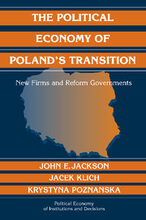and Balkan Europe
by IECOB & AIS Università di Bologna

The Political Economy of Poland's Transition
New Firms and Reform Governments

This book was first published in 2005. In the time span of a two-term US presidency, Poland went from an authoritarian one-party state with a faltering centrally planned economy to become a relatively stable multiparty democracy and a market economy with one of the highest GDP growth rates in Europe. A central feature of these economic and political reforms is a high rate of entry of new, domestically owned firms. This book uses detailed economic and political data to examine how these new firms contributed to the Polish transition. The authors test propositions about why some regions have more new firms than others and how the success of these new firms contributed to political constituencies that supported economically liberal parties. The book concludes by contrasting the Polish with the experiences of other transitional countries.
Table of contents
1. Why Poland?
2. The dynamics of the Polish political economy
3. Creative destruction and economic transitions
4. The social and distributional costs of transition
5. Individual attitudes and voting
6. De Novo job creation and election returns
7. Liberal economic interests and seat allocations
8. The political economy after 1997
9. The political economy of transitions: why Poland?
Download
PECOB: Portal on Central Eastern and Balkan Europe - University of Bologna - 1, S. Giovanni Bosco - Faenza - Italy
Chiudi la versione stampabile della pagina e ritorna al sito.